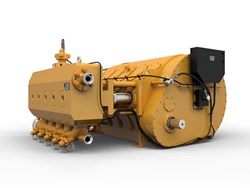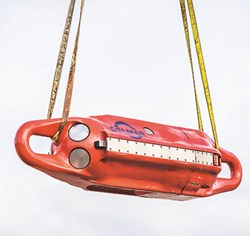Technical advances solve a variety of offshore problems
As was the case last year, nearly all of this group of new technologies and next-generation improvements on existing products remains split between drilling and production applications. However, a couple of items address completions and well intervention. Among the miscellaneous items are an advanced battery system for offshore facilities; upgraded mooring release technology; and electrical heat-based technology that creates downhole sealants in minutes. As always, the companies developing and offering these advancements have geared their efforts to saving time and money. ![]() <
<
PUMP ELECTRONIC MONITORING SYSTEM RELEASED
Caterpillar Oil & Gas has launched a new pump electronic monitoring system (PEMS).
It (Fig. 1) implements a different way of managing pumping operations. It can minimize downtime, preserve fluid ends and power end components—helping to avoid catastrophic failures. It monitors and analyzes high-speed data from several onboard sensors. If the data indicate cavitation or leaks occurring on the pump, the system will output, a warning message in real time to the pump operator, for immediate review and corrective action.
PEMS analyzes data from oil temperature, oil pressure, vibration, discharge pressure and suction pressure sensors. These data can be used to schedule preventative maintenance and rescue high-wear components. It is compatible with Cat Triplex and Quintuplex pump platforms.
NEW PRESSURE RELIEF VALVERATED TO 10,000 PSI
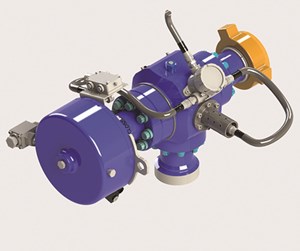
Cortec’s adaptable pressure relief valves (PRVs) include a diverse range of models and control panels tailored to individual specifications, Fig. 2. They are designed to offer users the safety, reliability and rapid response functions required to meet the challenges of today’s drilling operations. At OTC 2018, the company will showcase the new, commercially available CRV26 PRV, which has been engineered to protect drilling systems against the dangers of over pressurization. Visitors will be shown a full visual demonstration of the valve’s capabilities.
The new valve is the first of its kind to be rated to 10,000-psi systems. This will be available for 10,000-psi well control systems, as 20,000-psi BOP systems become more common. It will offer a very competitive alternative to other remotely operated PRV models, while offering reliability, precision and repeatability that conventional burst disks and manual spring reset valves cannot provide. Automated PRVs provide the highest degree of accuracy and reliability available, and are automatic or manually resettable for thousands of cycles. Applications in the field include frac system relief, mud pump relief, and managed pressure drilling (MPD).
UPGRADED MOORING RELEASE TECHNOLOGY
Delmar Systems has introduced an improved mooring release technology, RAR Plus, Fig. 3. The tool features a mechanical backup, which ensures the ability to detach the mooring in case the remote acoustic transmission fails to actuate the RAR. The mechanical release bypasses the acoustic, electronic and hydraulic systems, and can be actuated by the rig or with a nearby support vessel. After acoustic or manual activation, the RAR body can be pulled taut with the rig’s winch and nested with the trigger sleeve against the rig’s fairlead. With the RAR securely nested, the rig can sail away without AHTS vessel operations that can delay rig movement, if weather downtime or vessel breakdown occurs.
The upgraded device also has a significantly increased minimum break load (MBL) of 900 metric tons, so that RAR Plus isn’t the limiting MBL component, even in systems with high-strength elements in their mooring lines. The release load rating has also been increased to over 360 metric tons, allowing for disconnection at higher line tensions.
RAR Plus can be equipped with an acoustic telemetry system that has integrated sensors providing real-time continuous monitoring of local line inclination, depth and strain. These sensors and the topside processing unit communicate through acoustic modems to display direct-measured and indirect-calculated line tensions onboard the rig in real time. These data are independent of the rig’s existing load cell tension readings. The data stream can be integrated with 3D catenary monitoring systems, to mitigate mooring risks in congested fields. All data are saved in the topside processing unit and locally within the tool’s memory for post-analytical purposes.
Every RAR Plus has dual design and manufacturing certifications from ABS and DNV, ensuring stringent scrutiny on design, manufacturing and testing processes on each unit.
The company successfully installed the first set of RAR Plus units on a moored semisubmersible in the GOM. The technology saved the operator a significant amount of rig and vessel time during rig disconnections using the MOOR-Max releasable system, equipped with RAR Plus technology.
DRILLMEC’S CONTINUOUS CIRCULATION SYSTEM MITIGATES DEEPWATER CHALLENGES
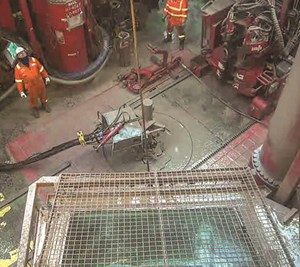
The need to develop new technologies to solve or mitigate drilling issues related to bottomhole pressure management arose in 2000, when the drilling industry moved to new challenges, such as HPHT wells and deepwater activities.
Oil companies have found continuous mud circulation to be a standard solution to drill challenging wells in a safe, efficient way. However, low systems reliability, potential safety issues and uncertain connection times slowed down routine application of continuous mud circulation in the drilling industry. Still, this technology represents a substantial drilling breakthrough, enabling continuous drilling operations along the entire drilling phase and preserving steady-state circulating conditions during connections.
The HoD (Fig. 4), a second-generation continuous circulation system developed and patented by Drillmec, has been utilized recently in ultra-deepwater exploration wells, in Black Sea water depths of 2,150 m. The use of the tool was planned to start from the 17½-in. phase, to the reservoir phase. A potential narrow drilling window, with uncertain formation gradients, required close control of the ECD and accurate indication of return flow from the well, even during connections, to avoid potential kicks and mud losses.
During the entire project in the Black Sea, the tool was set and rigged-up on a sixth-generation semisubmersible in less than 25 working hr. The system has been operational for 58 days with zero accidents and zero LTI, performing 194 connections with 100% success rates.
WELLHEAD SYSTEM REDUCES OFFSHORE COSTS
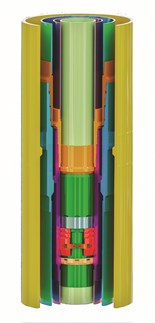
Kerui Petroleum has developed an offshore casing test system, based on research and development of conventional wellheads and offshore platform equipment. The MSW-1, shallow-water mudline suspension wellhead system (Fig. 5), offered through the company’s WEFIC wellhead brand, recently passed the API 17D performance test for underwater production systems in China.
The MSW-1 fully simulates the installation and pressure of the mudline environment. The system achieves pressure control and pressure dredging, during underwater drilling, by sealing and suspending each layer of casing at the mudline. Its relatively simple design enables rapid and safe installation. After testing, 95/8-in. and 20-in. casing can bear approximately 500 tons and, 1500 tons, respectively. The working pressure can reach 15,000 psi. The entire system can complete drilling and production operations in water depths up to 150 m. After use, it can be returned to the platform for well completion work. In shallow-water operations, it can be used to replace a deepwater wellhead, reducing costs by 10%–20%.
The system is intended to increase operational efficiency in the acquisition of oil and gas resources worldwide.
NON-CONTACT RADAR TRANSMITTER IMPROVES LEVEL-MEASUREMENT PERFORMANCE
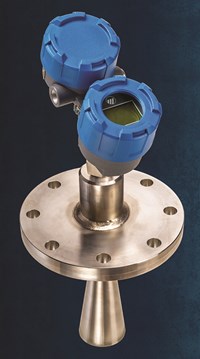
The PULSAR Model R86 non-contact radar transmitter from Magnetrol (Fig. 6) provides improved level-measurement performance in a wide range of upstream applications, including offshore cement slurry, drilling fluid and crude storage tanks. The latest in Magnetrol’s full portfolio of level instrumentation, the Model R86 features improved performance, advanced diagnostics and true versatility.
The transmitter’s 26-GHz radar signal has a smaller wavelength, resulting in smaller antennas and improved resolution. This is an important distinction for some process vessels, because the smaller beam angle allows for installation into process connections as small as 1½ in. As a result, the transmitter provides more precise, dependable level measurement and control.
Its user interface experience is driven by advanced diagnostics that transform the way that radar level measurement is used. Automated echo capture conveys real-time waveform and trend data, allowing users to assess the situation at a glance. In addition, the event history shows up to 20 events, including diagnostic and configuration data to pinpoint any issues. Troubleshooting tips provide practical solutions that can help reduce downtime.
The radar transmitter uses circular polarization, which eliminates the need to rotate the antenna orientation during commissioning. This simplifies installation and delivers proper alignment in virtually every application. High-temperature antennas are designed for use in operating conditions up to 750°F. Additionally, nozzle extensions ranging from 12 in. to 72 in. accommodate non-standard nozzle lengths and buried vessel standpipes.
FAMILY OF ROTARY STEERABLE SYSTEMS EXPANDED
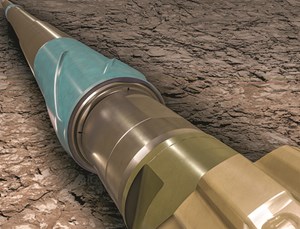
Rotary steerable systems (RSS) utilize magnetic and gravity field measurement for steering control. However, when the magnetic field measured downhole is disturbed, or does not have enough signal strength, the steerability of some RSS designs relying on magnetic measurements can be compromised.
Schlumberger has released the PowerDrive Xcel RSS (Fig. 7), the newest member of the PowerDrive RSS family which, to date, has drilled more than 270 million ft around the world. The new RSS was designed for directional assurance in high-profile directional drilling operations. It has an inertial steering mode and a unique, fully rotating point-the-bit system, to ensure directional trajectory control under challenging conditions. This includes congested platforms, cased-hole sidetracks and trajectories passing through the zone of exclusion (where Earth’s magnetic field projection on the cross-section of tool is low) or ferrous formations.
Multiple BHA runs are common and time consuming for sidetrack wells, and are even more relevant for multi-lateral operations. This can be restrictive for RSS tools without fully rotating sleeves—regardless of the steering mechanism, as the sleeves require consistent hole engagement to operate. The customizable bend-offset enables the RSS to provide an effective sidetracking solution and higher curvatures, when required, enabling efficiencies from kick-off to the target depth–extending the application for dogleg severity assurance. The RSS system also features advanced downhole automated close loops in inclination and azimuth, which can be customized to local challenges, to optimize the automated tool reaction, when the directional tendencies try to deviate from the wellbore path.
Statoil used the PowerDrive Xcel RSS’s inertial steering mode in the North Sea to drill close to producing wells, while keeping production from these wells online. Beyond the continuous production benefit, four wells were drilled and completed successfully, saving five days of rig time.
SIEMENS LAUNCHES ADVANCED BATTERY SYSTEMS
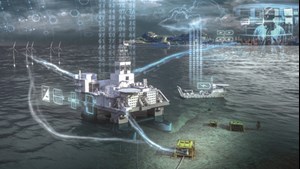
Siemens is combining its experience and competence in the maritime and oil and gas sectors—with expertise in electrical engineering, electronics and digitalization—to deliver advanced battery systems (Fig. 8), suited for both all-electric and hybrid power solutions.
The company will open a new battery manufacturing facility in Trondheim, Norway, in 2018 that will be fully automated and digitized. Here, the company will produce advanced battery systems and energy storage solutions for all-electric and hybrid power and propulsion solutions for both marine and offshore oil and gas applications. These unique, highly standardized energy storage systems monitor the voltage and temperature of individual cells, which increases safety and reliability.
The same battery storage solutions for marine and offshore environments are applicable to offshore wind farms (between loss of wind to start of back-up power supply), and are scalable to suit both small and large vessels with up to MWh battery energy storage sizes. In light of recent oil price volatility, offshore operators continue to develop and implement means to effectively navigate fluid commodity prices. However, cost constraints are not the only driver behind innovation. The long-term sustainability of the industry is also predicated on minimizing its environmental footprint.
Siemens has extensive experience and expertise with power and propulsion solutions for all-electric and hybrid vessels.
The firm also has developed DC power grid solutions that reduce emissions, fuel use and costs in marine vessels. The company plans to leverage its expertise in the marine market to develop low-emissions offshore solutions.
TAM PACKERS INCREASE EXPOSED SURFACE ARE
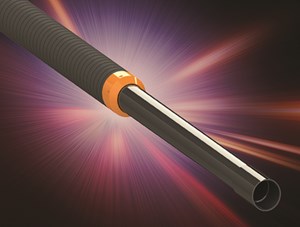
Swellable packers are not new technology. However, they are constantly being improved, tweaked and modified to meet expanding customer needs and expectations. Over the years, they have been custom-designed and manufactured with wildly varying diameters, lengths and elastomers to handle a wide range of applications, including zonal isolation, flow diversion, water/gas shut off, cement integrity, and more. Swellable packers can handle high pressures, high temperatures, and are cost-effective solutions to difficult problems.
When standard swellable packers cannot handle an application, the most common iteration is altering the elastomer compound to produce a different result. Unfortunately, sometimes customer requirements are too difficult to meet using alternative elastomer compounds. Adjusting the chemical properties of the elastomer can only exact so much change before performance is reduced. To maintain peak performance properties, another method of altering swell times must be used.
One common way to alter time to swell is to adjust the outer diameter of the elastomer in relation to the inner diameter it is swelling into. This has a few downsides. First, if the elastomer is too far away from the inner diameter, it can have reduced performance. Second, if the elastomer is too close to the inner diameter, there is added risk while running in hole. As a result of these downsides, swellable packers are most often manufactured with a standard spacing between outer and inner diameters. Instead, operators must use other methods to adjust the swell times to the customer’s satisfaction.
A new, innovative solution is to alter the geometry to increase the exposed surface area of the elastomer. By increasing the exposed surface area, the swell time can be improved drastically. Unlike simply increasing the OD, this does not cause issues with allowable run-in-hole time. For applications that cannot wait for a normal swellable packer, the TAM FastSwell packer (Fig. 9) may be the optimum solution.
INNOVATIVE, HIGH-DENSITY COMPLETION FLUID INTRODUCED
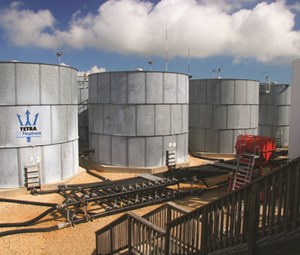
TETRA Technologies, Inc., has introduced the TETRA CS Neptune completion fluid (Fig. 10), formulated without undissolved solids, zinc or formates. The first generation was developed specifically for a complex, high-pressure deepwater project that required high-density clear brine solutions. It addressed the environmental challenges that face oil producers seeking an alternative to zinc brines (classified as “marine pollutants” and prohibited from being used in the North Sea) and its replacement, Cesium formate which, until recently, offered the only alternative for North Sea operations.
TETRA’s completion fluid provides another environmentally-friendly and cost-effective option that meets requirements for operations in the Gulf of Mexico and the North Sea, as well as other environmentally sensitive areas. It is an engineered solution formulated with renewable chemistry, stable at elevated temperatures and during storage, and mixable with standard clear brine blending equipment. It is compatible with most elastomers, poses low corrosion risk, and performs at low temperatures and high pressures without crystallization. The fluid also can be formulated as a low-solids reservoir drill-in fluid.
The fluid was deployed on four ultra-deepwater completions in the Gulf of Mexico, where the operator was required to produce into a host facility, with the production stream free from zinc and priority pollutants. Alternative solutions, such as extended flowback to temporary storage or cesium formate, were not viable, cost-effective options. The wells required 14.5- 15.0-ppg completion brine, with the well depth exceeding 30,000 ft, in a water depth of 7,200 ft and seabed temperature of 39°F. The completions were installed successfully, and the fluid performed with no issues, including no problems with true crystallization temperature (TCT) or pressure crystallization temperature (PCT) during a 15,000-psi BOP test. TETRA’s proprietary completion fluid displayed no compatibility issues with loss circulation material, polymers, and the synthetic oil-based mud (SOBM) was displaced without fluid property deterioration. The operator also used it as packer fluid.
TRELLEBORG’S ROTARY SEAL TARGETS HIGH PRESSURE
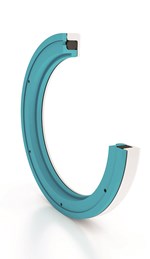
Trelleborg Sealing Solutions has launched a polytetrafluoroethylene (PTFE)-based, O-Ring-energized, single-acting rotary seal, Turcon Roto Glyd Ring DXL, Fig. 11. This seal is designed to meet the demands of high-pressure rotary applications within the oil and gas industry.
With its new design, the seal provides improved dynamic sealing efficiency and reduced friction by balancing the contact force on the dynamic lip under all service conditions, allowing for superior extrusion resistance and low torque. The seal is available in the company’s XploR range of NORSOK- and API-approved materials.
The seal can handle pressures up to 10,153 psi or speeds up to 16.4 ft/sec. The company recommends a maximum PV value up to 1.4 million (psi x ft/min) for optimal performance. These operating conditions are typically encountered in downhole tools, rotating control devices, hydraulic motors and pumps, and hydraulic swivels. Through extensive internal R&D and customer testing, the seal has exhibited extended life and outstanding wear resistance in abrasive media applications.
INTELLIGENT SENSOR IN A MUD-GAS SEPARATOR AND RFID FOR CERTIFICATES PROVIDE EFFICIENCIES TO OPERATORS
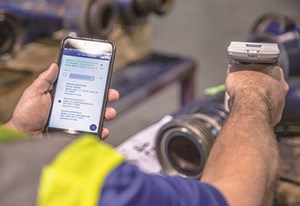
For OTC 2018, Weir Oil & Gas is focusing on new enhancements and technology that provide greater safety, cost savings, efficiency and up-time for operators. One such solution, Weir’s Mathena Mud Gas Separator Intelligent Level Sensor, accurately measures the levels within the mud-gas separator for MPD and under-balanced drilling operations, providing real-time data onsite. This gives operators much more time to avoid gas carryover to the active mud system and prevent an overflow scenario that would create a fluid spill from the igniter system. The sensor, which allows for the addition of a control valve, has been used in nitrogen-aerated drilling operations, in which overflow is a constant risk. Where operators previously had less than 20 min. of response time, they now have 3.5 hr to prevent overflow and eliminate liquid in the ecotank, reducing downtime and direct costs. This technology enhancement has generated hundreds of thousands of dollars in savings for installed sites.
Another solution vastly simplifies the time-consuming and error-prone process of maintaining an iron fleet. Traditionally, companies have relied on tedious manual data collection and physical storage of printed certificates—resulting in millions of dollars lost, due to the inability to produce required certificates for uninterrupted operation.
With its RFID AMP 2.0 technology (Fig. 12), Weir has transformed this process. Using optical character recognition technology, operators can accurately upload certificates, regardless of the issuing inspection organization, into a single cloud-based storage location, allowing for immediate retrieval to avoid unnecessary downtime. Tagging and accounting for 900 pieces of iron would typically take three employees three full workdays. With this technology, one employee accomplished that task in less than 60 min., with certificates. New enhancements include: the ability to scan certificates offline for uninterrupted workflow, regardless of internet or cellular-signal strength, enhanced asset details to enable operators to see the status of items they wish to edit on the mobile app, and the ability to write new tags for items, even when operators are away from their connected networks.
MODULAR SHAKER UPGRADES FLUIDS-HANDLING CAPACITY
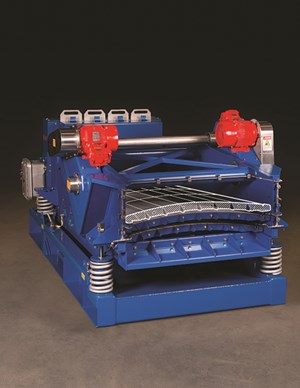
National Oilwell Varco (NOV) has successfully launched the SABRE modular shaker system, part of the Brandt line of solids-control products, Fig. 13. The shaker system is based on a scalable platform that can be changed easily from one to two, and two to three decks. This simple upgrade can be made in the field, which eliminates the need to change out the complete shaker system, and allows it to be quickly adapted to customer-specific applications.
The system’s more robust design differentiates it from its predecessors. Mounting the drive assemblies directly over the sidewalls of the basket allows for better energy transfer to the screens, and adjustable counterweights can compensate for G-force fluctuations when the number of decks is changed. These design features make the system a more potent primary screening system than similar models.
Ease of use and durability were principal factors when designing this shaker. The basket can be retrofitted onto most existing shaker skids, minimizing installation costs and downtime, and the super-lightweight screens, which weigh only 14 lb, can be changed out or repaired in a matter of minutes by a single operator, allowing immediate reuse. For operators whose drilling application requires the retention and recovery of costly lost-circulation or wellbore-stabilization materials, the shaker system's triple-deck configuration can be set up to retain these particles and reintroduce them into the fluid system while still removing unwanted low-gravity solids (LGS).
Field tests have shown already that this shaker has 1.5 to 2 times the fluids-handling capacity of existing high-performance shakers. This performance advantage enables it to better control LGS throughout the entire drilling process, thereby reducing dilution and associated logistics costs. The shaker also has proven to deliver dryer cuttings compared to other high-performance units; in the latest field runs, the system consistently reduced oil retention on cuttings from around 11% to below 9%, decreasing both haul-off and disposal costs.
ELECTRICAL HEAT-BASED TECHNOLOGY CREATES DOWNHOLE SEALANTS IN MINUTES
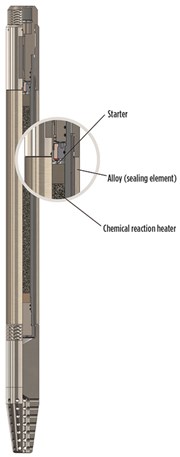
BiSN has released Wel-Lok M2M (Fig. 14), an electrical heat-based technology that utilizes a modified thermite heater, in conjunction with bismuth-based alloys, to create downhole sealants that are superior to traditional elastomer seals, resins and cement. The tools are run in-hole on electric line, requiring only 240 volts and 60 milliamps for 15 seconds.
Bismuth has a viscosity similar to water when in the liquid state, allowing it to flow into the smallest of areas, including cement micro-annuli, without the need to pump it into place. Additionally, bismuth is non-corrosive, environmentally-friendly and is not affected by H2S, CO2 or acid washes. It is non-explosive, so no license or handling permit is required.
Once on-depth, the modified thermite chemical reaction heater is activated to heat the alloy until it melts. The liquid alloy flows into the area that it is intended to seal, and solidifies and expands to create a seamless gas-tight seal. The seal is created in just minutes and is ready to test within one hour.
The technology dramatically reduces the heating time needed to create an effective seal—from hours to minutes. This significantly reduces downtime and cost. It also can be deployed on any standard wireline, with no special connection or power requirements.
After completing 16 successful commercial tool runs, to date, BiSN now operates in 12 geo-markets, partnering with some of the oil and gas industry’s major operators, to deliver solutions to the industry’s most important sealing challenges.
The core Wel-Lok M2M technology has been developed into a suite of 10 tools, all of which produce significant time, cost and environmental benefits. These can be applied across a spectrum of projects, from completions to interventions and abandonment.
ADAPTIVE RISERLESS/RISERED WELL INTERVENTION OFFERED
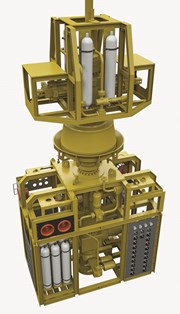
Wild Well Control brings new and alternative well intervention methods with its improved, second-generation 7Series system, Fig. 15. The firm’s approach to P&A involves leaving the casing in place, and placing competent, tested cement plugs in the outer annuli of a well. The redesigned 7Series allows operators to switch between riserless and riser-based deployment functions without resurfacing. The efficiencies and expansion of capabilities for this second-generation method will provide significant time-savings and cost benefits, beyond the norm. All subsea wells are potential candidates for this technology.
The system is more compact, and allows for installation on a traditional semisubmersible or drillship, as well as vessels. “With the opportunity to use an MPSV, MODU, or combination of both, the 7Series facilitates a significant enabling environment, whereby the operators can now look seriously at reducing their P&A liabilities, in the realm of approximately 50%,” said Andrew Barry, director of Subsea Solutions at Wild Well. The dimension changes in the system will allow for easier transportation, offshore mobilization, and installation.
The system involves multiple technologies and techniques, including DeepRange, a riserless P&A tool. Run in conjunction, this allows perforating and circulating plugging material through an outer annulus, rather than perforating and squeezing or cutting and pulling casing.
The significant enhancement to the system is its capability to switch, on the fly, between riserless and riser-based deployment functions without resurfacing. The well operations will determine the choice between using riserless or riser-based options. Some operations cannot be completed using a wireline, such as milling out a plug or cleaning out a wellbore with sand. If the planned operations change from light well intervention (slick or wireline) to medium well intervention (coiled tubing), the system can adapt, as needed. ![]()
- Coiled tubing drilling’s role in the energy transition (March 2024)
- Advancing offshore decarbonization through electrification of FPSOs (March 2024)
- The reserves replacement dilemma: Can intelligent digital technologies fill the supply gap? (March 2024)
- What's new in production (February 2024)
- Subsea technology- Corrosion monitoring: From failure to success (February 2024)
- Digital tool kit enhances real-time decision-making to improve drilling efficiency and performance (February 2024)
- Applying ultra-deep LWD resistivity technology successfully in a SAGD operation (May 2019)
- Adoption of wireless intelligent completions advances (May 2019)
- Majors double down as takeaway crunch eases (April 2019)
- What’s new in well logging and formation evaluation (April 2019)
- Qualification of a 20,000-psi subsea BOP: A collaborative approach (February 2019)
- ConocoPhillips’ Greg Leveille sees rapid trajectory of technical advancement continuing (February 2019)

